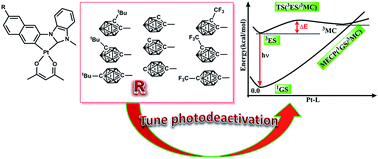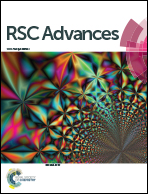A cyclometalated (C^C*) platinum(ii) NHC complex decorated via different carboranes to tune the photodeactivation mechanism: a theoretical investigation†
Abstract
Unveiling the photodeactivation mechanisms of transition metal complexes is crucial for designing high-efficiency phosphorescent materials. Herein, the photodeactivation mechanisms of cyclometalated (C^C*) platinum(II) N-heterocyclic carbene (NHC) complexes modified by carboranes were systematic study with the help of the density functional theory (DFT) and time-dependent density functional theory (TD-DFT). In order to illustrate the photodeactivation mechanisms, three vital photodeactivation processes, namely radiative decay process, temperature-independent nonradiative decay process and thermally activated nonradiative photodeactivation process, were taken into account. On the basis of calculated results, the emission wavelengths of the cyclometalated (C^C*) platinum(II) N-heterocyclic carbene (NHC) complex can be effectively tuned via the carborane-functionalized ligand structures. Meanwhile, compared with the original (NHC)Pt(II)(acac) complex, the radiative decay processes can be facilitated and the nonradiative decay processes can be managed via attaching distinct carboranes to the main ligand of the (NHC)Pt(II)(acac) complex, indicating that this is a feasible strategy for obtaining high-performance phosphorescence emitters.


 Please wait while we load your content...
Please wait while we load your content...